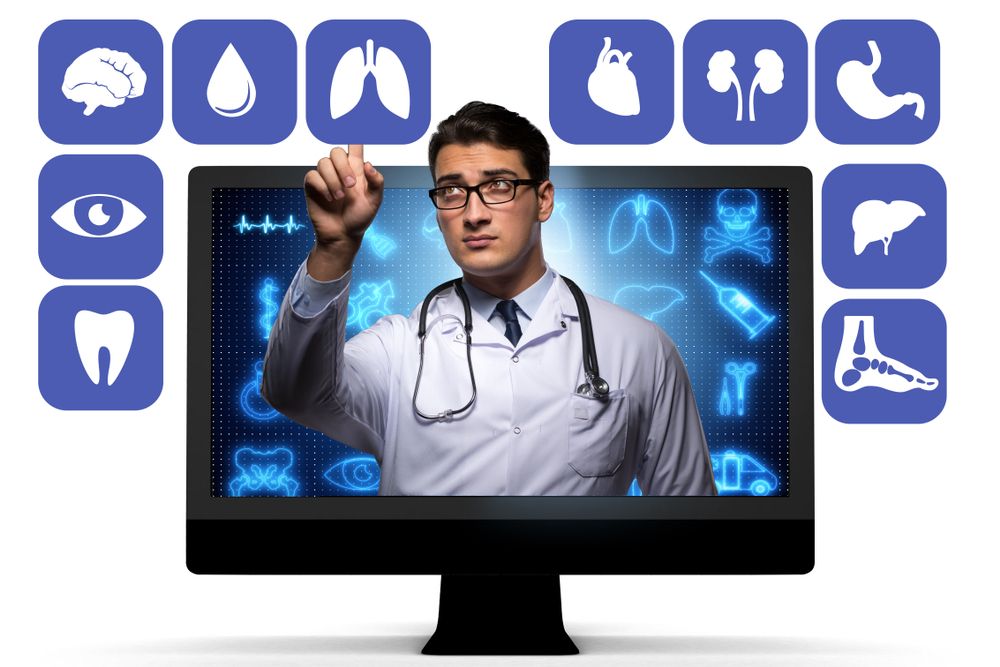Telemedicine refers to the use of the internet and technology to connect doctors to patients who live far away or who cannot otherwise easily make their appointments. (Learn More) This can be set up with software on a computer or an app on a smartphone, where a doctor can check in on a patient in real time, and a patient can ask questions about treatment or express concerns about their condition.
Telemedicine is very cost-effective, helping doctors stay in touch with numerous patients over a large geographic area, especially in distant areas with poor health care infrastructure. (Learn More) However, the effectiveness of telemedicine depends on the fidelity of the telecommunications infrastructure that patients can access and privacy laws that may not have caught up with the developing technology. (Learn More)
Telemedicine remains a vital component of health care for many doctors and patients, and it will likely expand at a rapid pace. (Learn More)
What Is Telemedicine?
Telemedicine is the practice of using computers, the internet, and related technology to offer health care over large distances. It is used to improve or even introduce access to medical services that would not otherwise be available in poorly connected areas, either in terms of physical or technological access. Telemedicine can also be used in critical care and emergency situations, where the information provided by a doctor over a telemedicine system can save a patient’s life.
Telemedicine is used to give patients and caregivers information about the feasibility of home treatments for different medical issues. Doctors can also use telemedicine systems for post-treatment check-ins, or follow-up for chronic care, especially if the patient cannot easily or safely leave their home to go to their doctor’s office.
Telemedicine can also help patients over holidays, weekends, late nights, or in any other circumstance when accessing regular medical care is difficult.
Telemedicine services and systems are designed to be intuitively used. In most situations, patients will need an online account or a toll-free phone number to contact their health care provider. By submitting basic information on their condition, patients request a “visit,” and the doctor can either accept the request, deny it for specific reasons, or reschedule it for a preferable date and time.
Pros and Cons of Telemedicine
Telemedicine offers many benefits, although there are some caveats that physicians and patients should be aware of.
On the plus side, telemedicine can be incredibly convenient for both parties, and convenience is important. A 2013 report from Cisco found that 74 percent of patients would choose easier access to their health care services, over needing to have in-person interactions with their providers. A doctor who offers telemedicine as part of their practice will give patients direct, on-demand care, with drastic reductions in the amount of time and money that come with in-person visits. For patients with limited or no insurance, a doctor’s visit can cost hundreds of dollars, and telemedicine can significantly cut that cost.
Patients who are restricted in their movement, either because of their medical condition, distance, or any other factors, can have a face-to-face conversation with their doctor on their computer screen or their smartphone.
Cost-Effectiveness
As much as telemedicine is convenient, it is also cost-effective. Insurance companies are big advocates of telemedicine systems because of how they lower service costs. Additionally, the effective use of telemedicine reduces non-urgent ER visits and wipes out transportation costs for required regular checkups.
Health Affairs writes that every year, millions of patients across the country choose to go without necessary medical care because they have limited access to reliable transportation, and the Journal of Community Health identified this as a barrier to treatment for the poor, the elderly, and the chronically ill. These populations would need ambulatory care the most, but they are dissuaded because of the prohibitive expense. Telemedicine would effectively bring the doctor to their respective homes and living situations.
Telemedicine also makes sense from a business perspective. In 2015, the American Hospital Association wrote about a telemedicine program that saved 11 percent in costs for providers, and it tripled the return on investment.
Beyond that, it is speculated that telemedicine can increase revenue for doctors by turning their on-call hours into billable time. Offering telemedicine as part of their services will attract new patients, cut down on the number of no-shows, and reduce overhead costs for practitioners who have an office outside their hospital.
Specialist Access and Patient Engagement
If patients need access to a specialist, this is also an area where telemedicine can be helpful, especially for patients who live in rural areas. The National Rural Health Association explains that only 43 specialists are available for every 100,000 patients living in remote areas, and this puts extreme strain on both patients and physicians. Patients have longer commutes to their appointments and might not be able to get consultations for specific diseases or chronic care.
With telemedicine, patients living in rural areas can still talk with specialists who can address their concerns. Similarly, specialists who want to expand their patient population can use telemedicine to reach an untapped demographic and geographic region.
Patients who are not able to regularly talk with doctors and receive care are more likely to be disengaged from the treatment process and achieving their health care goals. Healthcare IT News suggests that the convenience and reach of telemedicine systems can reduce costs for patients, and it might even lead to improving their health.
With telemedicine, patients can keep up with their appointments and treatment regimens. For patients who need to make lifestyle changes, such as eating less, cutting out tobacco, or exercising more, easier and more regular check-ins — as simple as a weekly face-to-face call on a smartphone app — can make these goals possible.
Furthermore, if patients have questions, experience unexpected side effects, or are in danger of falling behind on their milestones, telemedicine can ensure a timely intervention.
Telemedicine and Timeliness
Timeliness is one of the key advantages of telemedicine. The systems are set up to focus on the patient, critically increasing the quality of care that they receive. Their health care issues can be addressed in real time, and they can discover treatment options within minutes of logging onto their app and starting the conversation with their doctor.
This was seen in a 2015 study published by the American Journal of Managed Care, which wrote that patients who were enrolled in a telemedicine program scored lower on scores of depression, anxiety, and stress. They enjoyed 38 percent fewer hospital admissions than patients who were not in any such program.
Drawbacks of Telemedicine
Telemedicine has many advantages, but as a developing technology, there are also some drawbacks to its implementation.
Even though the programs are designed to be user-intuitive, it is still necessary to purchase equipment and hire trained staff to install the devices and educate people on their use. This costs both time and money. Without that training, however, doctors and patients are at risk for not using the system properly, and any errors can prevent patient engagement and lead to a decline in their health.
For telemedicine to be effective, it is imperative that all necessary medical staff be trained on the new systems and updated on newer technologies as required.
It is also possible that staffing requirements may decrease, which can be a double-edged sword for employees who really need their jobs. Kaiser Health News writes of how one nurse at a single location in Alaska can monitor 33 patients simultaneously. While this is an incredibly effective use of the program, it suggests that other nurses were let go because they were not needed, which can be its own problem.
Care Continuity

Care continuity is the concept of the patient and physician working together for the patient’s health care management. It is a cornerstone of modern medicine and integral to the physician having all the needed information to make sound treatment decisions, and the patient implementing those decisions to improve their health.
Telemedicine can greatly facilitate care continuity, but when patients use on-demand telemedicine services that connect them with a randomized health care provider, the connection they have with their primary (initial) doctor suffers. This may happen because the primary care provider is not available at the same time the patient is, but the patient is due for their regular check-in or has a concern that needs to be address.
A doctor filling in for the primary doctor might not have access to past records, and they might have to work with an incomplete history for the patient. Telemedicine systems will always try to connect the patient with their primary care provider, but this cannot always be guaranteed, and it is preferable that the patient see a different doctor than go without seeing a doctor at all. Nonetheless, there is the risk that the doctor who ends up seeing the patient won’t be fully informed on the patient’s progress.
This downside of telemedicine means that telemedicine providers have to come up with proper data solutions to maintain accessibility to patient records while still preserving patient confidentiality. It is likely that care continuity will increase as more health care providers move to telemedicine solutions, reducing the chances that patients will be paired with a doctor who is unfamiliar with their case. However, until those solutions are implemented, this remains an issue.
Poor Connections and Outdated Policies
Some doctors have expressed concerns about the limitations present in the current form of telemedicine. On the topic of “overcoming challenges in implementing telemedicine,” which Becker’s Hospital Review called health care’s “next frontier,” one doctor noted that bad technology and bad connections (a likely problem in rural areas) could cause “possible patient mismanagement.” He and other doctors fear that telemedicine removes the personal touch of a doctor and a patient sitting in the same room together. Additionally, there are some assessments that cannot be performed remotely and performing even simple checkups digitally can lead to inaccurate conclusions.
Since this is still a somewhat developing technology, a lot of laws regarding health care, reimbursement, and privacy protection cannot keep up with telemedicine, especially as telemedical systems are constantly updated and improved. Every development in telemedicine represents a potential stumbling block that might prevent providers and insurance companies from offering precise information about reimbursement to their patients.
Health care and insurance laws can differ wildly by state. Each state will have its own policies regarding telemedicine. It is in doctors’ best interests to do as much research as they can — for their own benefit, as much as their patients’ benefits — before signing up to offer their services in a virtual setting.
Telemedicine and the Future
Notwithstanding the learning curve, telemedicine is the way of the future. Research and Markets valued the telemedicine industry at $29.6 billion in 2017. Expect the market for telemedicine to grow by almost 20 percent within the next five years of that valuation.
This rapid development comes at a cost. The technology has limitations, as any technology does, but a number of health care providers see the vast potential and benefit to offering a wide array of health care services remotely. With careful implementation, telemedicine can help doctors reach patients whom they might otherwise never see, and this will address a new scope of health care needs.
References
What’s the Difference Between Telehealth and Telemedicine? American Academy of Family Physicians.
Cisco Study Reveals 74 Percent of Consumers Open to Virtual Doctor Visit. (March 2013). Cisco.
How to Get Health Care While Uninsured. (June 2012). The Billfold.
Shifting Non-Emergency Medical Transportation To Lyft Improves Patient Experience And Lowers Costs. (September 2018). Health Affairs.
Traveling Towards Disease: Transportation Barriers to Health Care Access. (October 2013). Journal of Community Health.
The Promise of Telehealth for Hospitals, Health Systems and Their Communities. (January 2015). American Hospital Association.
About Rural Health Care. National Rural Health Association.
Getting Down to Business With Patient Engagement. (April 2015). Healthcare IT News.
Leveraging Remote Behavioral Health Interventions to Improve Medical Outcomes and Reduce Costs. (February 2015). American Journal of Managed Care.
Electronic Intensive Care Unit Expands in Alaska. (March 2012). Kaiser Health News.
Continuity of Care, Definition of. American Academy of Family Physicians.
Overcoming 4 Challenges in Implementing Telemedicine, Healthcare’s Next Frontier. (February 2012). Becker’s Health IT & CIO Report.
Global Telemedicine Market Outlook 2022. (October 2018). Research and Markets.






